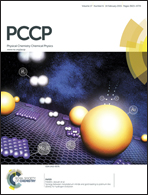Selective, direct detection of acetylcholine in PBS solution, with self-assembled fluorescent nano-particles: experiment and modelling†
Abstract
We report synthesis, characterisation and molecular modelling of a new fluorescent cyclotriveratrylene probe for acetylcholine in aqueous media, with emission around 430 nm thanks to extended conjugation. The probe discriminates acetylcholine from choline, with respective binding constants 540 and 240 M−1 in PBS buffered saline solution, an order of magnitude improvement over the previous best performance. Dynamic light scattering and transmission electron microscopy show the new probe self-assembles in ca. 5 nm diameter particles in PBS medium. Molecular modelling suggests that the high fluorescence quantum yield of the probe, 20% in aqueous media, is due to features of the molecular arrangement in the nano-particles, contributing both to exposure of the complexation site and to shielding of the fluorescent π system from quenching by water. Titration data for other quaternary ammoniums and modelling indicate that recognition of acetylcholine vs. choline depends on specific electrostatic interactions, and to a lesser extent on exclusion of water by hydrophobic–hydrophilic segregation. Probe–substrate interactions enhance the fluorescence of the probe by shielding against water and by flattening the π system.


 Please wait while we load your content...
Please wait while we load your content...